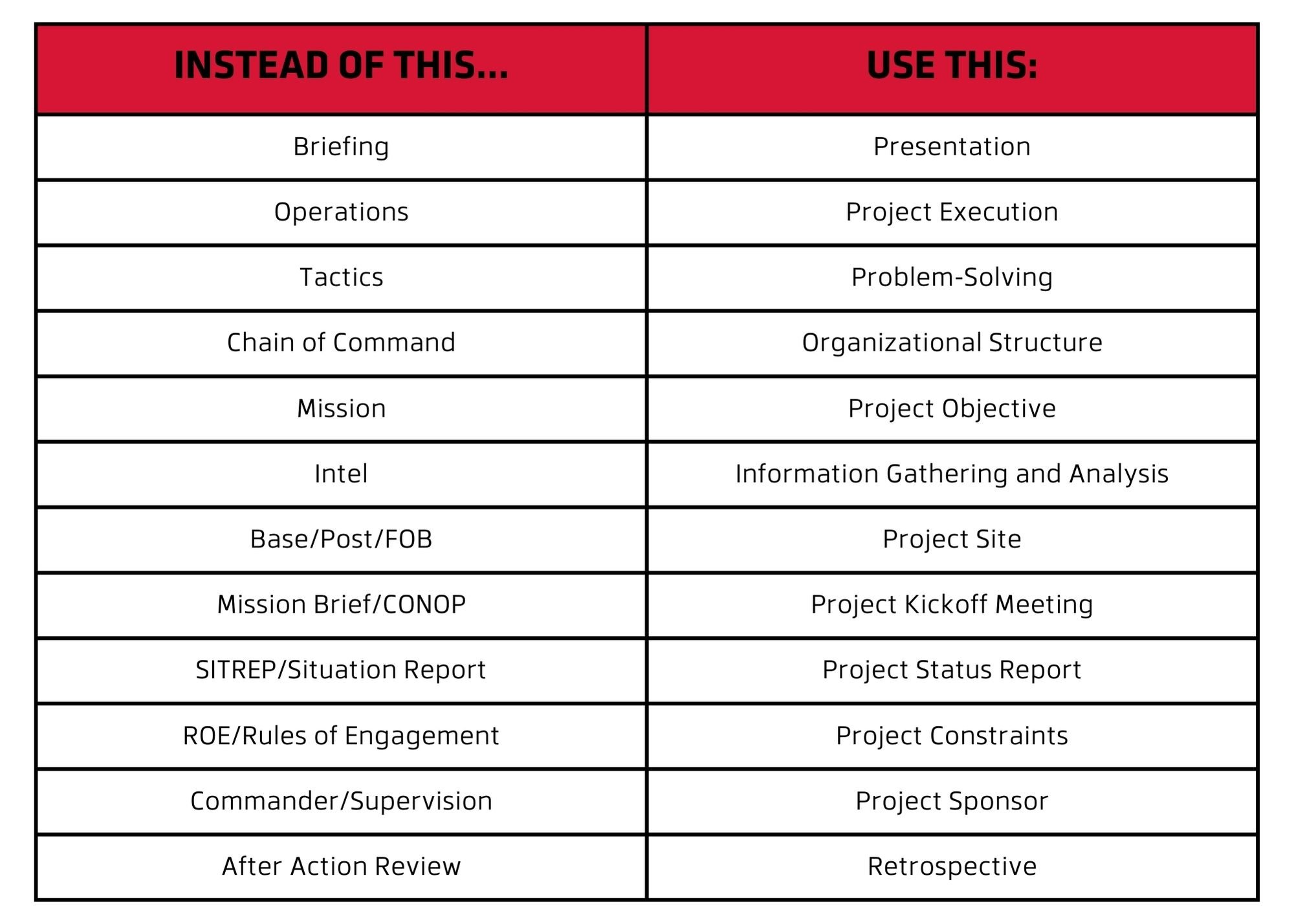Translate your military experience into project management success
Project Management is a growing field in Idaho. According to the Bureau of Labor Statistics, management level occupations in Idaho are projected to increase 10.3% from 2019 to 2029, much faster than the average for all other occupations. Examples include Project Manager, Construction Manager, and IT Project Manager positions.
Military members and veterans possess many transferable skills, such as leadership, teamwork, and problem-solving, which are critical to project management success. These skills, combined with the training and experience gained from earning a PMP certification, make them ideal candidates for project management positions.
It can be intimidating to sit down and fill out the PMP exam application without knowing exactly how to summarize and translate military-specific project management skills into commonly recognized civilian terminology. We’ve taken some of the guess-work out of the process and outlined key tips to help you tackle the PMP exam application.
Tip 1: focus on your project experience
A project is something that you might perform in your job role, even without the formal title of “project manager,” that is not considered part of your normal day-to-day operations. The PMBOK (Project Management Body of Knowledge) Guide defines a project as a temporary endeavor undertaken to create a unique product, service, or result.
Projects are temporary: They have a definite start date and a definite end date - whether they meet those dates is another topic, but they are designed to be completed within a certain timeframe.
Projects create a unique product, service, or result: This is what sets a project apart from operations. Where operations would be considered the “norm-” what is necessary to perform daily to sustain an organization, projects achieve something outside of the daily grind. For example: Upgrading an existing radar system or establishing a forward operating base (FOB). Yes, this could be part of your duties, but it isn’t typically something performed on a daily basis with the same or similar goal/outcome.
Be sure to reference the PMP Exam Content Outline. This document provides a detailed breakdown of the topics covered on the exam and can help you identify areas where your military experience may apply.
Tip 2: translate Military jargon to Civilian language
One of the best ways to make sure your PMP exam application is accepted without revision requests from PMI is to avoid military acronyms, abbreviations, and using military “jargon.” Be sure to use the terms that are commonly used in the civilian workforce.
Check out this table of examples:
Tip 3: Use the 5 project management process groups
The current standard for PMP exam applications calls for using tasks associated with the 5 project management processes in your project description, which comes directly from the Project Management Body of Knowledge. For example:
Initiating: Describe how you secured project resources, identified project stakeholders, and established project governance.
Planning: Describe how you worked with your team to establish project objectives, define project scope, and develop project plans and schedules.
Monitoring and Controlling: Describe how you tracked project progress, monitored project risks, mentored the team, and adjusted project plans and schedules as needed.
Executing: Describe how you coordinated project activities, managed project resources, and executed project tasks and deliverables.
Closing: Describe how you finalized project deliverables, closed project contracts, and conducted retrospectives.
By providing specific examples of your experience in each of these areas using civilian project management terminology, military members can demonstrate their project management skills and experience to civilian employers in a clear and concise manner.
examples of PMI Accepted Military Projects
Below are some samples of real projects that have been accepted by PMI as approved project descriptions. You’ll notice that templates vary, but they all cover typical elements of a project, such as project title, role, description, budget, goal/deliverable, and outcome. However, we do recommend specifically labeling the tasks of each project process by beginning or ending your descriptor sentence(s) with (IN) for initiating, (PL) - planning, (MC) - monitoring and controlling, (EX) for project launch/execution, and (CL) - closing. This way, the PMI associate reviewing the application can clearly identify and understand your experience.
Some details have been changed/omitted for privacy or security reasons. Changes are indicated by (X).
Project Example 1
PROJECT TITLE: Airframe Model Upgrade Transition
PROJECT OBJECTIVE: This was a hybrid project with a budget of approximately $(X) and a deadline of (X) years to transition from a legacy (X) aircraft to a modernized (X) aircraft and train/qualify all unit members in the new design series.
ROLE AND RESPONSIBILITIES: I served as the Project Manager and led a team of (X) for this project designed to transition to a newly fielded aircraft.
DESCRIPTION: I met with the higher-level chain of command (executive project sponsors) to develop the project charter and stakeholder register. Communicated with sponsors and stakeholders to identify necessary allocation of resources across project areas/phases. I also met with all internal unit members who acted as the customers for the project and gathered their high level requirements and set expectations (IN). Once the project was approved, I planned the project phases to be event-driven, based on resources, crew and equipment availability, and funding allocation. Detailed requirements were determined for the aircraft transfer and subsequent aircrew qualification courses, then added into a requirements traceability matrix. A detailed WBS was created to break out steps and processes for the actual aircraft transfer and design implementation of a training plan. Integrated procedures and communication plans into the project management plan to ensure adherence to governance rules and ensure that federal mandates and regulations were followed while utilizing OPA’s. I facilitated communication among the team, unit members, and our higher headquarters (executive sponsors) regarding the schedule to ensure they were informed of the project’s progress using Gantt charts, organizational charts, and other performance reports (EX).
DELIVERABLES: As key events happened (aircrew pre-position for quality control inspection, aircraft transfer, training and qualification courses), I confirmed the presence of MVP and the ability to move forward to the next phase (MC). After every completed phase, I facilitated after action reviews (retrospective sessions) to discuss and document what went right, what went wrong, and what needed to be improved before the next phase was entered (CL). It was necessary to meet regularly with both stakeholders and sponsors to ensure that resources were available for completing/transitioning phases.
OUTCOME: Successfully accepted the transfer of a new fully functional (X) model aircraft with all associated equipment packages. Successfully executed a training and qualification program with a 100% qualification rate for unit members resulting in a Readiness Level rating of (X), translating to a unit posture of “deployable.” The project was completed on schedule and within budget with sponsor approval.
Project Example 2
Served as a Project Manager for Special Operations Command (X) to standardize interagency funding process for military liaison positions in U.S. embassies at (X). Held meetings with project sponsors to identify stakeholders and discuss preliminary issues with funding between the Department of State and Department of Defense. Created project plans to outline high level and detailed work packages and to create a scope and budget. Held weekly progress meetings with the project team and as needed with stakeholders to identify barriers and ensure delivery of tasks in approved plans. Wrote a standard operating procedure to clearly define all tasks required for interagency funding process and established mechanisms for controlling future requests. Closed project by transferring all deliverables from project lifecycle, ensuring closing documentation and SOP was signed off, approved and archived, and lessons learned were communicated to project stakeholders for future interagency projects.
Project Example 3
My organization implemented a new aircraft emergency procedure checklist and emergency procedures process. As project manager, my role was to rollout training for (X) aviators to ensure correct usage of the new checklists and procedures. The objective was to reduce aircraft accidents and fatalities by reducing the number of incorrect aircraft emergency procedures performed each year. I was responsible for aircraft checklist procurement and distribution; training facilities coordination and scheduling (classroom and simulator); training, evaluation, and certification of instructors; implementation of the emergency procedure process training and evaluation program; addressed issues; documented lessons learned; archived project documents. My key deliverable was the training and evaluation of all assigned aviators in the use of the new aircraft emergency procedures process. The outcome of the project was satisfactory and met all regulatory requirements.
Learn More
By earning a PMP certification, military members, veterans, and their spouses can position themselves as highly qualified candidates for project management related jobs in Idaho. With the growing demand for project management occupations and competitive salaries, transitioning military members can compete for open job positions in Idaho.
If you’re located in, or transitioning to, Idaho after the military and want to learn more about filling out the project management exam application, or the next Mission43 PMP Certification Course, reach out to the education team using the form below.










